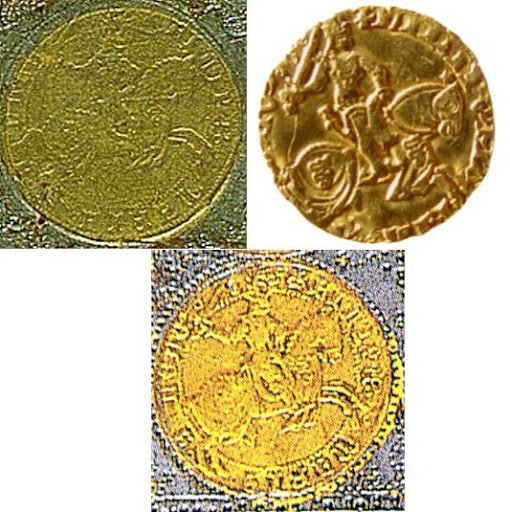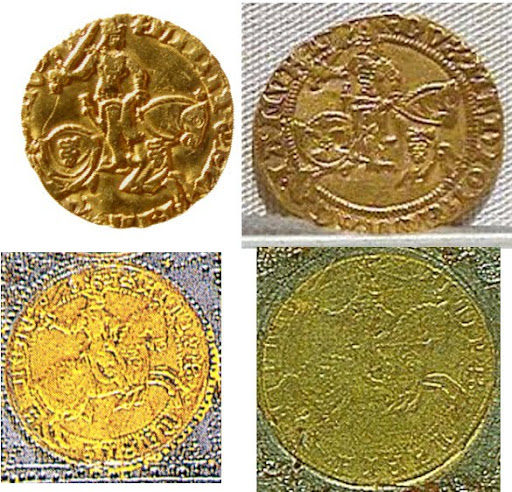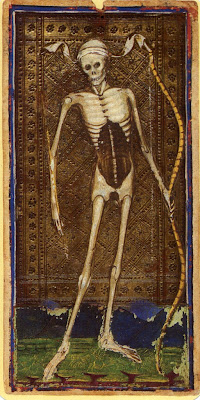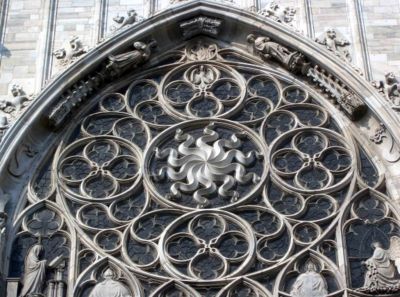Hello Mike,mikeh wrote: I read about Berti's claim on a link that Huck provided, but I haven't gotten around to ordering it on Amazon. (If you don't have it, I'll order it, just for this point!) Does Berti have pictures of the coins? If so, I'd love to see them. A similar claim was made in Andy's Playing Cards, about Filippo's 1936 coins with the "rearing horse" design. But when you compare the coins with the images on the cards, they're only similar, not the same.
I don't deny that there were real coins with that design. I was just saying that the coins might have come after the designs, and so appeared on the cards before the coins were made. You agree with that in your second paragraph. The only issue is how much earlier. Also, according to Andy's Playing Cards, Francesco did in fact issue coins with the same "rearing horse" design in 1450; she has pictures, and they are closer in appearance to the cards than the coins of 1436 are, but still not exact copies. See my post at http://www.tarotforum.net/showthread.php?p=1999548. So I'd love to see pictures of the 1442 coins.
here is a quote from Dummett, which I think might be Berti's source as well:
I always feel ashamed when translating Dummett into my poor English, but here it is:Michael Dummett wrote:(Il Mondo e l'Angelo, p.46) La maggior parte degli esperti, sebbene non tutti, ritiene che i mazzi Visconti di Modrone e Brambilla siano stati dipinti per Filippo Maria Visconti, e quindi risalgano, al più tardi, al 1447. La ragione più valida per questa ipotesi è che che, in entrambi i mazzi, i segni di seme di Denari presentano ora l'una , ora l'altra faccia di un'autentica moneta, il fiorino d'oro di Filippo Maria che reca il suo nome; questo tratto estremamente inconsueto non compare nel mazzo Visconti-Sforza. Nel mazzo Brambilla esso compare su tutte le carte superstiti del seme di Denari (Cavallo e Fante, dall'Asso al 3 e dal 5 al 10); nel mazzo Visconti di Modrone, si trova sulle carte dal 4 al 10, ma non sull'Asso e sul 2 o su alcuna delle figure (il 3 manca).
(footnote 7:) La tecnica di queste rappresentazioni del fiorino di Filippo Maria rimane un mistero. Pare evidente che sono state fatte per mezzo di un autentico conio, ma i numismatici ci assicurano che le immagini sulle carte sono più grandi della moneta stessa; forse l'artista usò il conio per una medaglia.
Most, but not all, experts maintain that the Visconti di Modrone and Brambilla decks have been painted for Filippo Maria Visconti, so they date to no later than 1447. The most valid reason for this hypothesis is that, in both decks, the signs of the suit of Coins present now one, now the other face of an authentic coin, the golden fiorino of Filippo Maria, bearing his name; this extremely unusual feature does not appear in the Visconti-Sforza deck. In the Brambilla deck, it appears in all the surviving cards of the suit of Coins (Knight and Page, from Ace to 3 and from 5 to 10); in the Visconti di Modrone deck, it appears on cards from 4 to 10, but not on the Ace and 2 or any of the court cards (the 3 is missing).
(footnote 7:) The technique of these representations of the golden fiorino of Filippo Maria is still a mystery. It seems clear that they were made by means of an authentic coinage, but the numismatics assure us that the images on the cards are larger than the coin itself; possibly the artist used the coining stamp (conio) for a medal.
Good images of the coins are avilable on moneymuseum.com.
I attach a couple of processed details from the Yale library site. I think that "Maria" can be read on the side of the coin with the Knight, and FI MA on the reverse.












